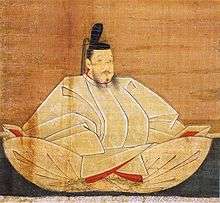Ashikaga Yoshimochi
Ashikaga Yoshimochi (足利 義持, March 12, 1386 – February 3, 1428) was the 4th shōgun of the Ashikaga shogunate who reigned from 1394 to 1423 during the Muromachi period of Japan. Yoshimochi was the son of the third shōgun Ashikaga Yoshimitsu.[1]

Family
- Father: Ashikaga Yoshimitsu
- Mother: Fujiwara no Yoshiko (1358–1399)
- Wife: Hino Eiko (1390–1431)
- Concubines:
- Tokudaiji Toshiko
- Kohyoe-dono
- Children:
- Ashikaga Yoshikazu by Eiko
- A son by Eiko
- A son by Eiko
- A daughter adopted by Ōdaiji family by Eiko
- Kashi-in by Eiko
- a daughter by Toshiko
- Jiju'in by Kohyoe-dono
- Daiji'in
- Sojiin
Succession and rule
In 1394, Yoshimitsu gave up his title in favor of his young son, and Yoshimochi was formally confirmed in his office as Sei-i Taishōgun.[1] Despite any appearance of retirement, the old shōgun didn't abandon any of his powers, and Yoshimitsu continued to maintain authority over the shogunate until his death. Yoshimochi exercised unfettered power as shōgun only after his father died in 1408.[2]
In 1398 – in the 6th year of the reign of King Taejo of Joseon, a diplomatic mission was sent to Japan.[3] Pak Tong-chi and his retinue arrived in Kyoto in 1398 (Ōei 5, 8th month). Shogun Yoshimochi presented the envoy with a formal diplomatic letter; and presents were given for the envoy to convey to the Joseon court.[4]
Significant events shape the period during which Yoshimochi was shōgun:
- 1408 – Yoshimochi comes into his own as a shōgun.[5]
- 1409 – Ashikaga Mochiuji becomes Kantō kubō.[5]
- 1411 – Yoshimochi breaks off relations with China.[6]
- 1413 – Emperor Go-Komatsu abdicates; Emperor Shōkō ascends throne in repudiation of agreement; renewed hostility between shogunate and supporters of Southern Court.[5]
- 1415 – Dissension between Ashikaga Mochiuji, the Kantō Kubō in Kamakura, and Uesugi Zenshū (the Kantō Kanrei).[6]
- 1416 – Uesugi rebels.[5]
- 1417 – Uesugi's rebellion quelled by Mochiuji.[6]
- 1419 – Korean attack on Tsushima (Ōei Invasion).[6]
- 1420 – Serious famine with great loss of life.[6]
- 1422 – Resurgence of Southern Court supporters.[5]
- 1423 – Yoshimochi cedes authority to his son.[5]
Yoshimochi followed his father's example by formally ceding his powers to a young son, fifth shōgun Ashikaga Yoshikazu, who was then 18.[7]
Era of Yoshimochi's bakufu
The years in which Yoshimochi was shōgun are more specifically identified by more than one era name or nengō.[8]
- Ōei (1394–1428)
Notes
- Titsingh, Isaac. (1834). Annales des empereurs du japon, p. 321., p. 321, at Google Books
- Titsingh, p. 325., p. 325, at Google Books
- Kang, Etsuko Hae-jin. (1997). Diplomacy and Ideology in Japanese-Korean Relations: from the Fifteenth to the Eighteenth Century, p. 275., p. 275, at Google Books
- Titsingh, p. 322., p. 322, at Google Books
- Ackroyd, Joyce. (1982) Lessons from History: the Tokushi Yoron, p. 330.
- Sansom, George. (1961). A History of Japan, 1334–1615, p. 142., p. 142, at Google Books
- Titsingh, p. 329., p. 329, at Google Books
- Titsingh, pp. 321–329., p. 321, at Google Books
References
- Ackroyd, Joyce I. (1982) Lessons from History: the Tokushi Yoron. Brisbane: University of Queensland Press. ISBN 9780702214851; OCLC 7574544
- Kang, Etsuko Hae-jin. (1997). Diplomacy and Ideology in Japanese–Korean Relations: from the Fifteenth to the Eighteenth Century. Basingstoke, Hampshire; Macmillan. ISBN 978-0-312-17370-8; OCLC 243874305
- Sansom, George Bailey (1961). A History of Japan: 1334–1615. Stanford: Stanford University Press. ISBN 978-0-8047-0525-7; OCLC 43483194
- Titsingh, Isaac. (1834). Nihon Ōdai Ichiran; ou, Annales des empereurs du Japon. Paris: Royal Asiatic Society, Oriental Translation Fund of Great Britain and Ireland. OCLC 585069
| Preceded by Ashikaga Yoshimitsu |
Shōgun: Ashikaga Yoshimochi 1394–1423 |
Succeeded by Ashikaga Yoshikazu |
